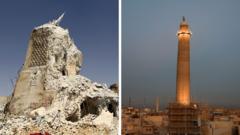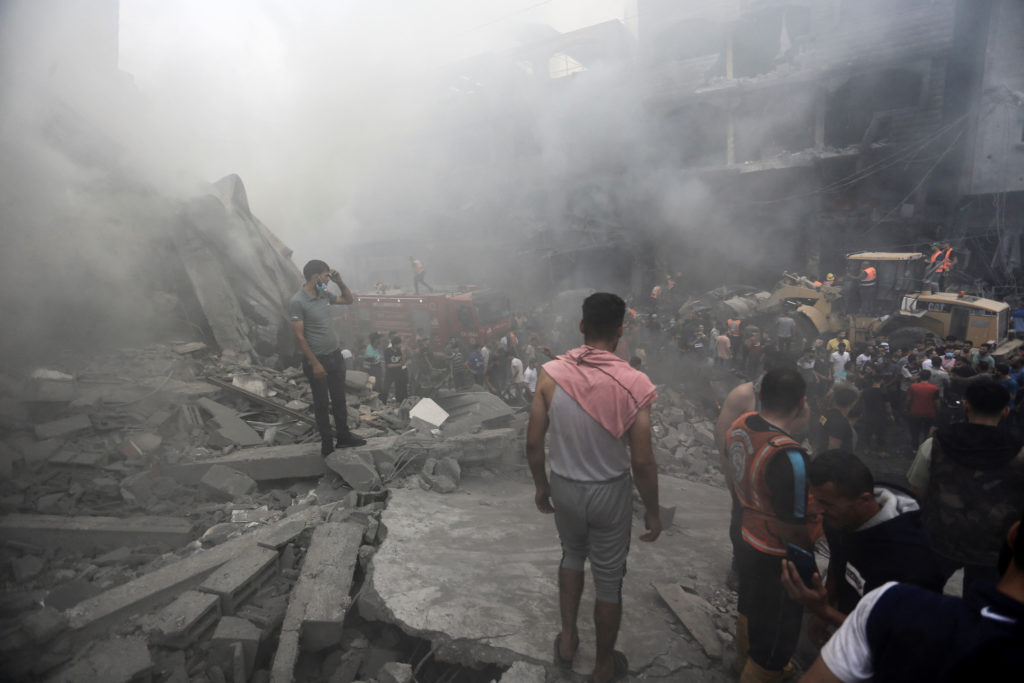In a remarkable turn of events, the historic city of Mosul is witnessing the restoration of its once-cherished landmarks following years of devastation from the occupation of the extremist group, Islamic State (IS). The reconstruction efforts, spearheaded by UNESCO, began a year after IS was expelled from the city in 2017. The initiative, which comes with a budget of $115 million funded by supporters like the United Arab Emirates and the European Union, aims to rebuild not only the physical structures but also the community spirit that was long a hallmark of Mosul's diverse society.
On Wednesday, a significant ceremony will take place to mark the reopening of historic sites, attended by UNESCO's director-general, Audrey Azoulay, and Iraqi Prime Minister Mohammed Shia' al-Sudani. Local artisans, residents, and representatives from various religious backgrounds will participate, symbolizing the unity needed to heal the deep cultural and communal wounds inflicted during IS's reign.
In the ruins of Mosul, where the echoes of conflict lingered, stood landmarks crucial to the city's identity, such as the iconic leaning al-Hadba minaret and the al-Nuri mosque—both of which were destroyed as IS retreated. Mosul photographer Ali al-Baroodi vividly recounts the horror of witnessing his city's transformation into a ghost town during the liberation battle. He reflected, "It was not the city that we knew—it was like a metamorphosis—that we never imagined not even in our worst nightmares."
The reconstruction efforts are multi-faceted. Under the guidance of local and international experts, community members have rallied to restore not only the physical structures, including 124 historic houses and several religious sites, but also to reforge ties among Mosul's diverse population. Dominican priest Father Olivier Poquillon noted that re-establishing trust between different groups has been a monumental achievement, crucial for ensuring the restored buildings do not become targets for further discord.
Maria Rita Acetoso, the lead architect on the project, emphasized the cultural significance of restoring Mosul, stating, “This project demonstrates that culture too can create jobs, can encourage skills development, and can make those involved feel part of something meaningful.” Over 1,300 local youth have already been trained in traditional craft skills, while thousands of jobs have emerged from the rebuilding process.
Eight years on from the devastation, the sounds of community life are gradually returning, with the bells at al-Tahera Church ringing out once more. Residents like Mustafa, whose house dating back to 1864 was recently restored, expressed joy at returning to their roots, hopeful for the future. Meanwhile, Abdullah, who also returned to his family's longstanding home, described the emotional impact of witnessing its revival, saying, “I can't describe the feeling I had.”
While the scars of war remain, the restoration of Mosul’s historic landmarks serves as a beacon of resilience and hope, supporting the city’s gradual recovery. As resident Ali al-Baroodi eloquently put it, “It’s truly like seeing a dead person coming back to life in a very, very beautiful way—that is the true spirit of the city coming back to life.”
On Wednesday, a significant ceremony will take place to mark the reopening of historic sites, attended by UNESCO's director-general, Audrey Azoulay, and Iraqi Prime Minister Mohammed Shia' al-Sudani. Local artisans, residents, and representatives from various religious backgrounds will participate, symbolizing the unity needed to heal the deep cultural and communal wounds inflicted during IS's reign.
In the ruins of Mosul, where the echoes of conflict lingered, stood landmarks crucial to the city's identity, such as the iconic leaning al-Hadba minaret and the al-Nuri mosque—both of which were destroyed as IS retreated. Mosul photographer Ali al-Baroodi vividly recounts the horror of witnessing his city's transformation into a ghost town during the liberation battle. He reflected, "It was not the city that we knew—it was like a metamorphosis—that we never imagined not even in our worst nightmares."
The reconstruction efforts are multi-faceted. Under the guidance of local and international experts, community members have rallied to restore not only the physical structures, including 124 historic houses and several religious sites, but also to reforge ties among Mosul's diverse population. Dominican priest Father Olivier Poquillon noted that re-establishing trust between different groups has been a monumental achievement, crucial for ensuring the restored buildings do not become targets for further discord.
Maria Rita Acetoso, the lead architect on the project, emphasized the cultural significance of restoring Mosul, stating, “This project demonstrates that culture too can create jobs, can encourage skills development, and can make those involved feel part of something meaningful.” Over 1,300 local youth have already been trained in traditional craft skills, while thousands of jobs have emerged from the rebuilding process.
Eight years on from the devastation, the sounds of community life are gradually returning, with the bells at al-Tahera Church ringing out once more. Residents like Mustafa, whose house dating back to 1864 was recently restored, expressed joy at returning to their roots, hopeful for the future. Meanwhile, Abdullah, who also returned to his family's longstanding home, described the emotional impact of witnessing its revival, saying, “I can't describe the feeling I had.”
While the scars of war remain, the restoration of Mosul’s historic landmarks serves as a beacon of resilience and hope, supporting the city’s gradual recovery. As resident Ali al-Baroodi eloquently put it, “It’s truly like seeing a dead person coming back to life in a very, very beautiful way—that is the true spirit of the city coming back to life.”






















